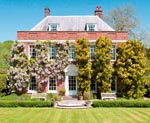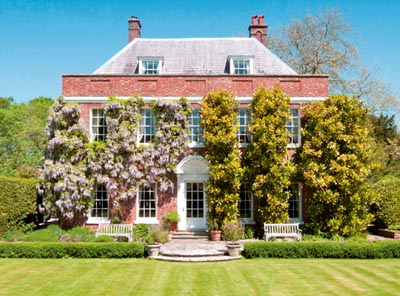Hampshire's finest country houses
Penny Churchill chooses timeless Hampshire country houses for sale


So far, it hasn't been a vintage year for grand Hampshire country houses not so much because no one wants to buy, but because owners aren't sufficiently motivated to sell. So the launch onto the market in this week's Country Life-for the first time in more than 20 years-of secluded Michelmersh Court at Michelmersh, near Romsey, is bound to cause a flurry of excitement among buyers looking to live in style near Hampshire's cultural capital, Winchester, 10 miles to the north. Savills (020-7499 8644) quote a guide price of ‘excess £6 million' for the classic Queen Anne house, listed Grade II*, which stands in 21 acres of enchanting formal gardens, paddocks and woodland, with ‘sensational' views across the gardens to the Test Valley beyond.
In a county of estates and country houses built by heroes, it's easy to overlook the clergy's contribution to Hampshire's architectural heritage. After all, many of them were landed gentry, too, and wealthy rectors lived their lives accordingly. Eighteenth-century Michelmersh Court was built as a rectory around the core of a much older house-once part of the manor held by the monks of St Swithun's Priory from 1205 to 1539-and remained in Church hands until 1920. One of its most colourful incumbents was the Rev Barrington Gore Browne, a formidable character who was rector of nearby St Mary's church from 1884 to 1913. He was a stalwart of the Temperance movement who exerted a considerable influence on the local community. Things are a lot jollier now.
Having escaped the ravages of a full-scale country-house makeover, Michelmersh Court retains a wonderful sense of period, with its high ceilings, traditional sash windows and wealth of original panelling. Apart from necessary structural work, the owners have made few non-essential changes to the house, except for general decoration and the addition of creature comforts. Instead, they have concentrated their efforts on establishing the immaculate gardens and grounds that provide an impressive foreground to this most elegant of Hampshire houses.
Accommodation includes six reception rooms, four first-floor bedrooms with five bathrooms and five second-floor bedrooms with a further two bathrooms. There is also a three-bedroom lodge and a two-bedroom garage flat. Most newcomers to the Winchester area know the where-abouts of Jane Austen's house at Chawton and naturalist Gilbert White's house, The Wakes, at Selborne. But there are other luminaries whose association with some of Hampshire's loveliest houses tends to get forgotten. They include the historian Edward Gibbon, author of the classic History of the Decline and Fall of the Roman Empire, who lived at Buriton Manor, near Petersfield, in the latter half of the 18th century (Country Life, November 12, 1948) and the Bonham Carter family, which owned the Buriton estate from 1826 to 1958.

* Subscribe to Country Life and save £60
Beautifully restored by its current owners, semi-retired investment banker Timothy Holland Bosworth and his wife, Elizabeth, historic The Manor House at Buriton, listed Grade II*, is one of few elite country houses for sale at the Hampshire end of the South Downs National Park, at a guide price of £7.5m for the whole, through Grantley (01483 893939) and Knight Frank (01483 565171).
The imposing brick-built manor, whose Georgian front belies an older core dating from the 12th century, stands next to St Mary's church on the edge of this quiet east Hampshire village. Set in 8.3 acres of walled gardens and paddocks against the backdrop of the South Downs, The Manor House forms one side of an enchanting courtyard of restored historic buildings that includes the former coach house, stables, dairy and tithe barn, currently used as a profitable wedding and events venue. This, together with the rental income from the manor's five cottages, represents an excellent prospect for a buyer prepared to take on the mantle of its present enterprising owners, says selling agent Nigel Mitchell of Knight Frank.
Sign up for the Country Life Newsletter
Exquisite houses, the beauty of Nature, and how to get the most from your life, straight to your inbox.
Inside, too, The Manor House is steeped in period charm, with its 17th-century reception hall, 18th-century garden hall and staircase, sitting room and drawing room with fine period fire-places, intimate dining room, family kitchen and breakfast room and elegant second-floor library. The bedrooms are laid out on two floors and include four spacious suites in the Georgian part, with views over the gardens to the Downs, and four further bedrooms and bathrooms in the other, older part of the house.
In November 1822, during one of his famous Rural Rides, William Cobbett travelled along east Hampshire's famous Hangers steep, wooded areas of chalk or greensand, where the trees seem to hang from the sides of the hills-to the village of Hawkley, six miles from Peters-field. Pulling up his horse, he sat and looked down, ‘and it was like looking from the top of a castle down into the sea'. The landscape around Hawkley is as spectacular now as it was then, and even more protected than before, thanks to its location within the South Downs National Park.
The Winchester office of Jackson-Stops & Staff (01962 844299) is selling, for the first time in 59 years, one of Hawkley's best houses, the Grade II-listed Hawkley Place, with 5.6 acres of formal gardens and grounds, at a guide price of £3.4m. Originally a small, L-shaped Tudor farmhouse, it was substantially extended in 1862 by the Victorian architect Samuel Teulon, who built nearby Hawkley Hurst and the village church of St Peter and St Paul for local landowner J. J. Maberly.
Hawkley Place is a solid family house with 6,458sq ft of living space, including entrance and staircase halls, four main reception rooms, a kitchen/break-fast room, six main bedrooms, three bathrooms, a further attic bedroom and a playroom. Out-buildings include stabling, garaging, workshops, stores and a converted hayloft and darkroom.
The same agents are handling the sale of charming, 18th-century Lower House Farm at East Meon, four miles west of Petersfield, another location within the South Downs National Park much favoured by City bankers and lawyers. A guide price of £2.45m is quoted for the roomy, six-bedroom main house with a cottage, outbuildings, superb equestrian facilities, gardens and paddocks, 10 acres in all. A separate two-bedroom cottage with a quarter-acre of garden is on offer at £300,000.
A year on from the opening of the Hindhead Tunnel, London commuters have finally lost their fear of the unknown in terms of commuter journey times, to the benefit of Petersfield and its surrounding villages, says Mark Wheeler of Hamptons International in Guildford. The area around the village of Steep, two miles north of Petersfield, was a rich source of inspiration for the poet Edward Thomas, who moved there from Kent with his family in 1906, and died at the battle of Arras in 1917. Today's commuters may be equally inspired by the sale of handsome, 17th-century Downgate Farm in the nearby hamlet of Steep Marsh, a beautifully modernised five-bedroom farmhouse in a courtyard setting, with views of the Hangers and 16 acres of gardens, grounds and paddocks. Hamptons (01483 572864) quote a guide price of £3.25m.
Country Life is unlike any other magazine: the only glossy weekly on the newsstand and the only magazine that has been guest-edited by HRH The King not once, but twice. It is a celebration of modern rural life and all its diverse joys and pleasures — that was first published in Queen Victoria's Diamond Jubilee year. Our eclectic mixture of witty and informative content — from the most up-to-date property news and commentary and a coveted glimpse inside some of the UK's best houses and gardens, to gardening, the arts and interior design, written by experts in their field — still cannot be found in print or online, anywhere else.
-
 About time: The fastest and slowest moving housing markets revealed
About time: The fastest and slowest moving housing markets revealedNew research by Zoopla has shown where it's easy to sell and where it will take quite a while to find a buyer.
By Annabel Dixon Published
-
 Betty is the first dog to scale all of Scotland’s hundreds of mountains and hills
Betty is the first dog to scale all of Scotland’s hundreds of mountains and hillsFewer than 100 people have ever completed Betty's ‘full house’ of Scottish summits — and she was fuelled by more than 800 hard boiled eggs.
By Annunciata Elwes Published
